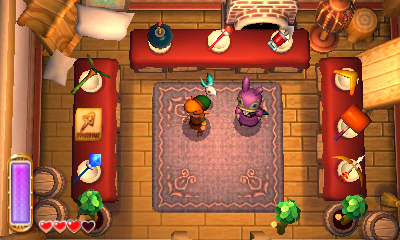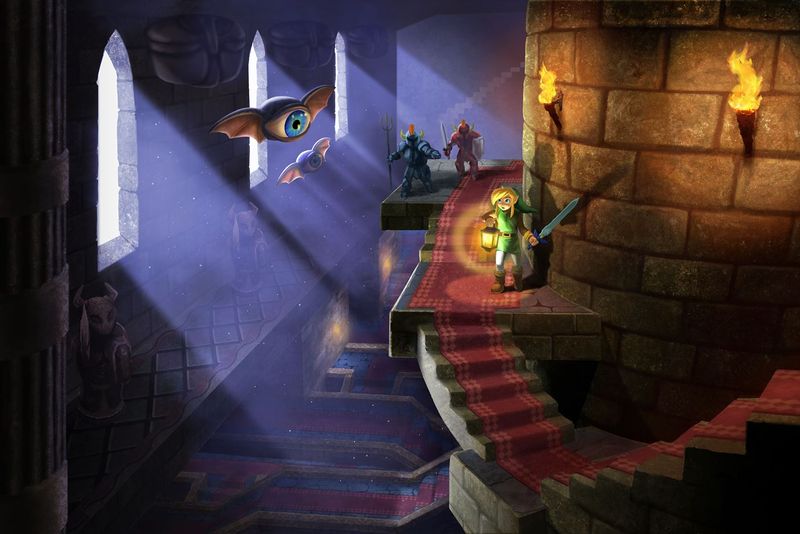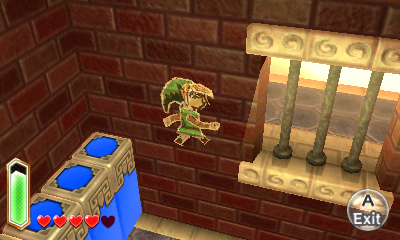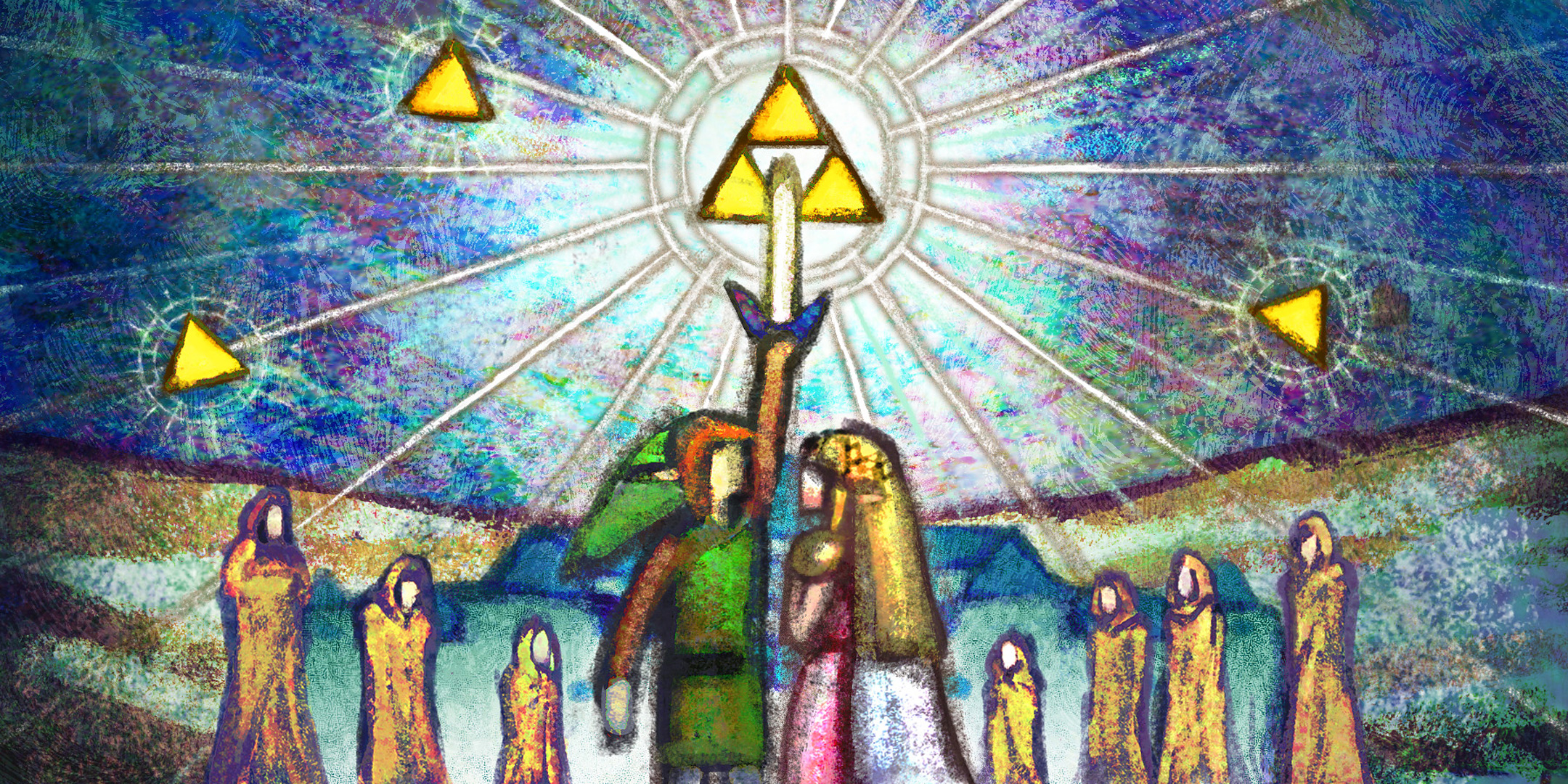A Link Between Worlds, the latest entry in the Legend of Zelda series, is a direct sequel to one of the earliest games in the storied franchise, A Link to the Past. It features the same map of Hyrule, most of the same items, and very similar gameplay. A Link Between Worlds is steeped in the history and tradition of the series, but in looking to the past, the developers have managed to change up the standard Zelda formula we have become so used to. Traditions have been reimagined in interesting new ways, that has me very excited for the future of the series.
 One of the most exciting changes to the standard Zelda formula in Between Worlds is the ability to tackle dungeons in just about any order you wish. While this nonlinear approach has been seen before in the Zelda series, as early as the first game in fact, it is the way it is executed in Between Worlds that makes it feel so new and refreshing. From early in the game, you have access to all the weapons and items you will need to defeat the dungeons by way of Ravio’s Shop. This shop allows you to rent items, or for a much heftier price, buy them outright.
One of the most exciting changes to the standard Zelda formula in Between Worlds is the ability to tackle dungeons in just about any order you wish. While this nonlinear approach has been seen before in the Zelda series, as early as the first game in fact, it is the way it is executed in Between Worlds that makes it feel so new and refreshing. From early in the game, you have access to all the weapons and items you will need to defeat the dungeons by way of Ravio’s Shop. This shop allows you to rent items, or for a much heftier price, buy them outright.
Giving the player access to most of the items they will need from the get go shake up the tired “One Item Dungeon” practice the series has been using for years. While Between Worlds still makes use of this formula, it makes smart use of other items within the dungeon’s walls as well. I may not be required to bring the Bombs into one dungeon to best it, but it may make some of the puzzles easier to complete if I do have them. It helps make puzzles feel fresh and satisfying, as you can take different approaches to completing them.
 Exploration is extremely well executed in A Link Between Worlds, easily the best since The Wind Waker, released over 10 years ago. While this is the same map, of Hyrule at least, used in A Link to the Past, not everything is in the same place as it was before. Between Worlds sets you free to roam Hyrule from early on, and most of the map will be available to the player. This creates an interesting experience for veterans of a A Link to the Past, who will revisit familiar locations only to make a new discovery there; while players who have no experience with A Link to the Past will explore completely uncharted territory, with everything being a new experience.
Exploration is extremely well executed in A Link Between Worlds, easily the best since The Wind Waker, released over 10 years ago. While this is the same map, of Hyrule at least, used in A Link to the Past, not everything is in the same place as it was before. Between Worlds sets you free to roam Hyrule from early on, and most of the map will be available to the player. This creates an interesting experience for veterans of a A Link to the Past, who will revisit familiar locations only to make a new discovery there; while players who have no experience with A Link to the Past will explore completely uncharted territory, with everything being a new experience.
Discovery is the key to the success of A Link Between Worlds. Nintendo has wisely done away with a lengthy, tutorial filled beginning, instead allowing players to venture forth and figure things out for themselves. You’ll always know where you are supposed to go in Between Worlds, but figuring out exactly how you are going to get there is left for you to discover on your own. Nintendo relies on environmental clues, such as a large rock blocking your way, or an entryway surrounded by water, to inform players of what item they need to advance further. This creates a greater sense of satisfaction for the player, as they feel they have figured the puzzle out for themselves, instead of being flat out told what they need to do to move further along in the adventure.
 Finally, Between Worlds continues the tradition of including a new gameplay concepts into the Zelda series, such as sailing in The Wind Waker or Link’s Wolf Form in Twilight Princess. This time around Link is capable of transforming into a 2D painting to move across walls and other flat surfaces. Unlike past games, Link’s painting ability does not feel like a gimmick done simply to make things different, and plays a large role in puzzle solving and exploration. I hope to see further gameplay innovations be implemented as successfully as the Painting Link was, and I’d be lying if I said I wouldn’t mind seeing another game using this Painting ability.
Finally, Between Worlds continues the tradition of including a new gameplay concepts into the Zelda series, such as sailing in The Wind Waker or Link’s Wolf Form in Twilight Princess. This time around Link is capable of transforming into a 2D painting to move across walls and other flat surfaces. Unlike past games, Link’s painting ability does not feel like a gimmick done simply to make things different, and plays a large role in puzzle solving and exploration. I hope to see further gameplay innovations be implemented as successfully as the Painting Link was, and I’d be lying if I said I wouldn’t mind seeing another game using this Painting ability.
A Link Between Worlds is one of the best Zelda games ever made. By looking to the past, it has manage to reinvigorate and liven up a series that was beginning to feel very formulaic. I hope the Zelda series will continue to evolve in this way, and I am incredibly excited to see what is in store for the future of the series.






